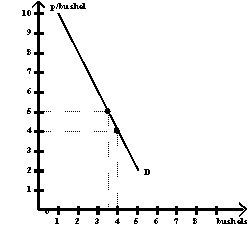Multiple Choice
Exhibit 5-25 
-Exhibit 5-25 shows a hypothetical demand curve for soybeans. The vertical axis measures the average price per bushel in dollars. The horizontal axis measures billions of bushels per year. If perfect weather boosts the harvest from 3.5 billion bushels to 4.0 billion bushels (a 13 percent increase) , what must happen to average price in order for the increased production to be sold?
A) The average price must increase by $1 per bushel, a 22 percent increase.
B) The average price will remain at $5 per bushel.
C) The average price must fall by $0.58 per bushel, a 13 percent decrease.
D) The average price must fall by $1 per bushel, a 22 percent decrease.
E) It is not possible to answer without knowing exactly how much supply decreases.
Correct Answer:

Verified
Correct Answer:
Verified
Q64: Price elasticity of demand is typically negative
Q79: Cross-price elasticity measures the responsiveness of the
Q81: Exhibit 5-5 <img src="https://d2lvgg3v3hfg70.cloudfront.net/TB4915/.jpg" alt="Exhibit 5-5
Q86: Exhibit 5-15 <img src="https://d2lvgg3v3hfg70.cloudfront.net/TB4915/.jpg" alt="Exhibit 5-15
Q89: If the income elasticity of demand for
Q133: Substitutes are pairs of products with<br>A)positive cross-price
Q146: The absolute value of the price elasticity
Q237: The demand for Olin skis is likely
Q241: The general term elasticity refers to a
Q242: If demand is elastic, a decrease in